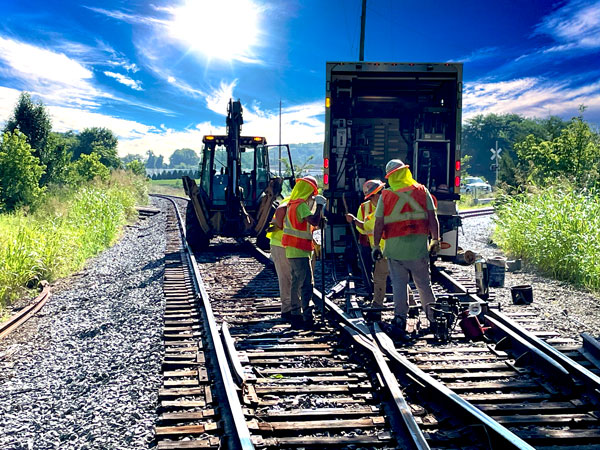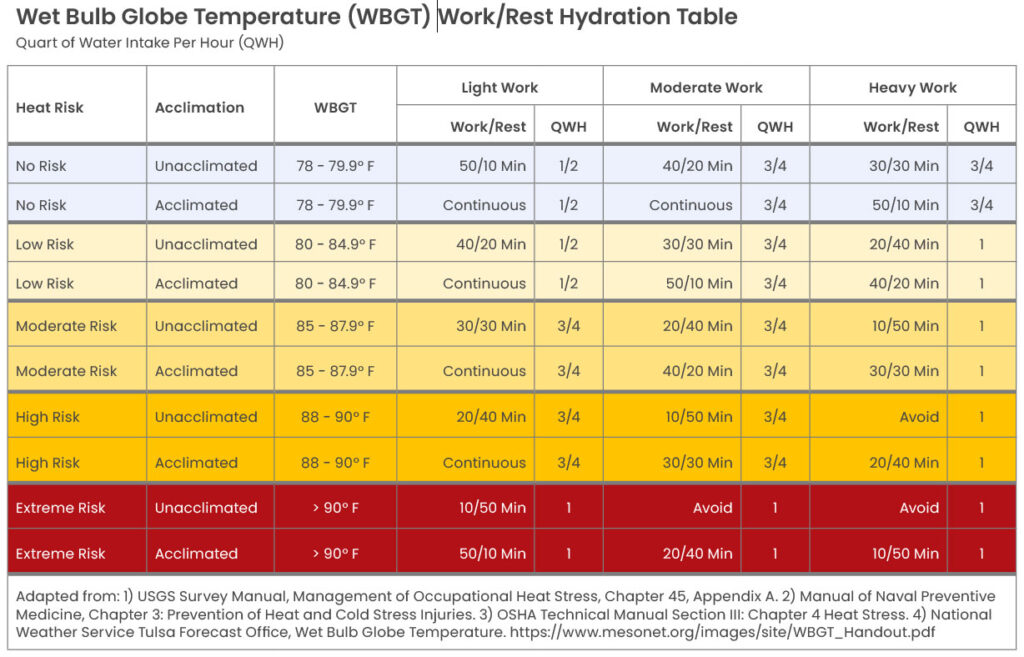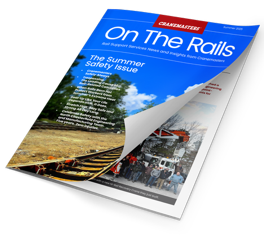When Rails Burn Hot: Protect Workers from Summer’s Extreme Heat
- Summer 2025
- Cranemasters

The Progression of Heat Stress
There are several stages the body goes through on its way to sustaining a serious heat injury.
As the body warms, blood vessels dilate, increasing circulation in the extremities and near the skin, releasing even more heat. Soon, we start to sweat. As sweat evaporates, it takes excess heat with it. However, it also takes the moisture from our bodies. Our blood volume decreases, and the heart must work harder to maintain blood pressure. Dehydration can occur very quickly, especially when sweating for an extended period. If we can’t sweat, there is no evaporation, and the heat gets trapped inside our bodies.
One of the more minor signs that evaporation isn’t working is heat rash. The irritation of the skin from excessive sweating, or sweat trapped beneath the skin, causes small, itchy bumps. Next are muscle cramps, typically occurring in the limbs or stomach. At this point, core body temperature is likely elevated. Cramps are a sign to take a break in a cool place, drink lots of fluids, and consume electrolytes.
As our core body temperature rises, so does the possibility of heat exhaustion. At this point, the body has lost too much fluid and/or electrolytes. The core body temperature is elevated, but still under 104°F.
Signs of Heat Exhaustion
- Headache
- Profuse sweating
- Dizziness
- Nausea or vomiting
- Elevated heart rate
- Tiredness or weakness
- Pronounced thirst
- Fast but weak pulse
- Abnormally fast breathing
- Cool, clammy skin
- More muscle cramps
Heat exhaustion can quickly progress to heat stroke, so it is imperative to respond rapidly to symptoms if they appear. Anyone with signs of heat exhaustion should move to a cool, shaded area and take immediate measures to cool down, such as removing excess clothes, fanning themselves, applying ice packs or towels soaked in cool water, and drinking fluids, ideally with electrolytes. Emergency medical services are required if symptoms do not improve within an hour. It typically takes 1-2 days to recover from heat exhaustion.
A rare but serious heat-related injury that can occur around this stage is rhabdomyolysis (pronounced “rhab·do·my·ol·y·sis”). Rhabdomyolysis is the rupture, death, and breakdown of muscle tissue and requires prompt medical intervention. Symptoms include muscle pain and cramping, weakness, swelling, stiffness, extreme fatigue, confusion, headache, nausea or vomiting, dark urine, and prolonged or disproportionate muscle soreness lasting more than three days. If rhabdomyolysis is suspected, seek immediate medical attention as it can cause severe complications and even permanent disability.
Finally, we arrive at heat stroke—a severe condition that carries the risk of death or permanent injury. By now, the body has exhausted its ability to regulate its temperature. Our internal temperature has risen to 104°F or higher, where tissue death, alteration or loss of consciousness, organ damage, and shock will set in. Untreated, heat stroke can quickly lead to death.
Heat Exhaustion vs. Heat Stroke—Know the Difference
Though heat stroke shares many symptoms of heat exhaustion (headache, nausea or vomiting, dizziness, weakness, elevated heart rate, and low blood pressure), there are some unique signs to look out for. Namely, brain-related symptoms—confusion, delirium, blurred vision, behavior changes, seizures, and slurred speech. Additionally, symptoms may include fainting, dry skin, rapid and shallow breathing, and significant changes in skin color (such as becoming pale or flushed).
If heat stroke is suspected, call emergency services and take immediate steps to cool the person down. Move the person into a cool or shaded environment, apply ice packs to armpits and/or neck, pour cool water over them, or rotate the use of cool or cold soaked towels. Additionally, do not give the person water while waiting for emergency services, as people with heat stroke often aspirate. Do not give fever reducers either, as they can worsen organ damage and will not lower the core body temperature of a person experiencing heat stroke. Depending on the severity and the promptness of treatment, recovery can take anywhere from a few days to over a year, with some individuals sustaining permanent damage to the brain or other organs.
Staying Cool and Safe
To avoid heat stress and injury, follow these general recommendations: stay cool, stay hydrated, seek shade or well-ventilated areas, limit exertion, and wear loose, breathable clothing. All well and good, except for the fact that rail work is not exactly conducive to any of these things.
Outside, the sun is beating down, the temperature (and worse, the humidity) is high, and job sites often aren’t exactly in the most convenient locations. Access to air conditioning may be nonexistent. Even “inside,” cars are rarely, if ever, air conditioned—quickly becoming ovens on wheels. For safety, workers must often wear bulky protective gear that traps heat and prevents the body’s natural cooling mechanisms from working correctly.
Additionally, the work frequently involves strenuous physical activity. Most of the “risk factors” for heat stress are checked for rail workers by default. All things considered, following the general “best practices” seems almost impossible. But there are still plenty of things we can do to stay safe (and cool).
The first line of defense is heat stress training, which employers are required to provide for their workers. Numerous training courses are easily accessible online.
Next, workers need to stay hydrated, and that starts the night before. During work, employees should aim to drink 4 cups of water per hour, plus electrolytes. For an eight-hour workday, that’s a minimum of two gallons per person. Keep coolers full of clean ice, fresh water, and sugar-free Gatorade.
On an individual level, workers should wear UV-protective clothing that is loose, lightweight, breathable, and moisture-wicking. Woven fabrics tend to drape better than knits, and a loose weave allows for good breathability, which is essential for heat dissipation. Moisture-wicking fabrics, such as those found in athletic wear, are designed to pull sweat away from the skin, which is particularly important in high-humidity conditions.
As for color, consider the fit. Light or reflective colors work best when worn close to the skin, as they reflect heat away from the body. However, when worn in a loose garment, they also reflect our body heat and trap it inside our clothes. Dark colors are better for loose-fitting clothes, as they can help conduct heat away from the body and even promote airflow. Take breaks away from active danger zones where you can remove your protective gear and allow for better cooling.
For more extreme conditions or when used under heavy protective gear, cooling vests or neck wraps that incorporate ice packs are beneficial. Although they can be expensive initially, they are reusable and allow for quick re-freezing. Instant cold packs are also helpful to have on hand, as they provide instant access to cold without relying on traditional cold storage methods (such as ice or refrigeration).

An adequate acclimation protocol for new or returning workers is also crucial. Over half of heat-related deaths happen on the first day, and 70% within the first week. OSHA recommends starting with 20% of the normal work duration on the first day and increasing by 20% each subsequent day until they reach their normal shift length. Schedule unacclimatized workers for shorter work periods and more frequent breaks (refer to the wet bulb temperature table below for recommended work and break times based on heat level, exertion, and acclimation).
Monitor workers closely throughout the day and encourage them to drink water and take breaks as needed. Always notify a supervisor at the first sign of trouble. Implementing a buddy system is an effective way to ensure worker safety without compromising efficiency. When evaluating a job site, take note of radiant heat, air movement, heat conduction, sun exposure, and relative humidity. Adjust accordingly. Battery-operated fans can help mitigate stagnant air, and portable shade options will also improve conditions and increase safe work duration.
One of the most important factors to consider is the Wet Bulb Globe Temperature—the lowest temperature that water evaporation can cool to. A wet bulb temperature of 80-85°F is considered low risk. 85-88°F is moderate risk, 88-90°F is high risk, and 90F and above is considered extreme risk. At a wet bulb temperature of 95°F, no amount of fans and shade is enough—sustained exposure will be fatal without air conditioning, without exception. While heat acclimation can dramatically increase how much an individual can tolerate, we are all bound by the limits of physics.
Another thing to note is that these considerations only include healthy adults. Additional risk factors to consider are age, level of fitness, pre-existing medical conditions, and some medications. Heat tolerance also varies between individuals. Some workers may need more frequent breaks or to avoid higher levels of heat exposure entirely.
Heat is nothing to mess with—but it can be managed with proper training, preventative measures, and a little planning. Establishing heat guidelines and a robust set of safety protocols is crucial to the success and longevity of teams operating in extreme conditions. Not to mention, heat stress also negatively affects work speed and quality. Practices that help workers stay cool do more than just keep them safe—they also decrease accidents and can improve overall productivity and outcomes.
- “Fighting for Stronger Heat Protections for Rail Workers.” SMART Union, June 26, 2025. https://www.smart-union.
org/fighting-for-stronger- heat-protections-for-rail- workers - “What Causes Hyperthermia?” Cleveland Clinic, June 2, 2025. https://my.
clevelandclinic.org/health/ diseases/22111-hyperthermia - “Heat Exhaustion.” Cleveland Clinic, June 2, 2025. https://my.
clevelandclinic.org/health/ diseases/21480-heat-exhaustion - “Rhabdomyolysis Signs and Symptoms.” Cleveland Clinic, June 2, 2025. https://my.clevelandclinic.
org/health/diseases/21184- rhabdomyolysishttps://my. clevelandclinic.org/health/ diseases/21184-rhabdomyolysis - “Symptoms of Heat Stroke.” Cleveland Clinic, June 2, 2025. https://my.
clevelandclinic.org/health/ diseases/21812-heatstroke - “Stay Healthy in the Heat!” Railroad Operations and Safety Training, July 16, 2016. https://
railsafetraining.com/stay- healthy-heat - “OSHA’s Proposed Heat Injury and Illness Prevention Rule: Smart TD Takes a Stand for Rail Workers’ Safety.” SMART Union, February 12, 2025. https://www.smart-union.
org/oshas-proposed-heat- injury-and-illness-prevention- rule-smart-td-takes-a-stand- for-rail-workers-safety - “Heat Stress | Environmental Health and Safety.” University of Iowa. Accessed July 2, 2025. https://ehs.research.
uiowa.edu/occupational/heat- stress - Sherriff, Lucy. “What Is the Best Clothing to Keep You Cool in a Heatwave?” BBC News, June 17, 2024. https://www.bbc.com/
future/article/20230802-what- is-the-best-clothing-to-keep- you-cool - “Heat Stress Guide.” Occupational Safety and Health Administration. Accessed July 2, 2025. https://www.osha.gov/
emergency-preparedness/guides/ heat-stress - “Heat – Protecting New Workers.” Occupational Safety and Health Administration. Accessed July 2, 2025. https://www.osha.gov/
heat-exposure/protecting-new- workers - Heat acclimation and hydration with wet bulb globe. Accessed July 2, 2025. https://www.mesonet.org/
images/site/WBGT_Handout.pdf - “Understanding Wet-Bulb Temperature: Risks of High Wet-Bulb Temperatures Explained.” ClimateCheck. Accessed July 2, 2025. https://climatecheck.com/blog/
understanding-wet-bulb- temperature-the-risks-of-high- wet-bulb-temperatures- explained - Charles Goetsch Law Offices LLC. “Railroad Workers Are at High Risk for Heat-Related Illnesses.” Charles Goetsch Law Offices LLC, July 27, 2022. https://www.gowhistleblower.
com/blog/2022/07/railroad- workers-are-at-high-risk-for- heat-related-illnesses





